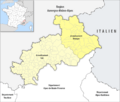Arrondissements of the Hautes-Alpes department facts for kids
The Hautes-Alpes department in France has two main areas called arrondissements. Think of an arrondissement like a large district or a borough within a bigger region. These are special administrative divisions used in France and some other countries.
Each arrondissement has a main city called a subprefecture. This city acts as its capital. If the main capital city of the entire department is inside an arrondissement, then that city serves as both the department's capital and the arrondissement's subprefecture.
Arrondissements are further divided into smaller areas called communes. Communes are like towns or villages, and they are the smallest administrative divisions in France.
The two arrondissements in the Hautes-Alpes department are:
| INSEE code |
Arrondissement | Capital | Population (2014) |
Area (km²) |
Density (Inh./km²) |
Communes |
|---|---|---|---|---|---|---|
| 051 | Briançon | Briançon | 35,752 | 2,138.1 | 16.7 | 37 |
| 052 | Gap | Gap | 104,131 | 3,410.5 | 30.5 | 130 |
Contents
What is an Arrondissement?
An arrondissement is a type of administrative division in France. It helps to organize the country into smaller, easier-to-manage parts. Each department in France is divided into these arrondissements.
The main city of an arrondissement is called a subprefecture. This city is where the local government for that area is located. It helps manage services and public administration for the people living there.
History of Hautes-Alpes Arrondissements
The way the Hautes-Alpes department is organized has changed a few times over the years. Here's a quick look at its history:
Early Divisions (1790)
When the Hautes-Alpes department was first created in 1790, it was divided into four districts. These districts were Briançon, Embrun, Gap, and Serres. The very first capital city for the department was Chorges. However, in the same year, the capital was moved to Gap.
Changes in the 1800s
In 1800, the districts were reorganized into three arrondissements. These new arrondissements were Gap, Briançon, and Embrun. This structure helped to better manage the different parts of the department.
Modern Structure (1926)
Later, in 1926, the arrondissement of Embrun was removed. This change left the Hautes-Alpes department with the two arrondissements we see today: Gap and Briançon. This structure has remained the same since then.
Related pages
Images for kids


